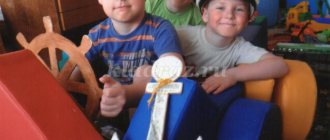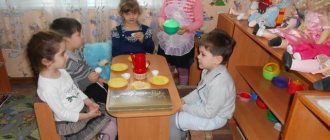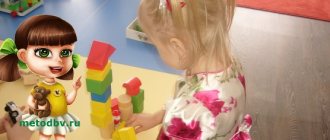We will build the city ourselves!
Probably everyone will agree that role-playing games are a model of adult society. What does the child gain from this game? It depends only on us. Learning through role-playing games is an effective and lightweight method, as it takes place in a playful way and is supported by the child’s interest in the game’s actions and design.
A plot game is a reproduction of events occurring in life or in a literary work. The main condition of the game is that children have knowledge about one side or another of reality, about the activities of people in them, and their specific situational behavior. This knowledge serves as a source for constructing the plot of the game, the implementation of roles, and role relationships.
The value of the game lies not only in the fact that it not only expands the possibilities of knowledge of the spheres of reality, but also prepares children for life in society. I bring to your attention the following game for children in the pre-school group.
Goals
:
- Create conditions for the formation of conscious behavior in road transport situations, preserve the life and health of children.
- Strengthen children's ideas about the street.
- Reinforce the concepts of what a “street”, “sidewalk”, “roadway” is; traffic rules, use knowledge in practical activities.
- Expand children's vocabulary through the use of prepositions and adverbs in speech: near, near, between, in front, behind, on the left, on the right when describing the location of the house.
- Expand your orientation in the surrounding space.
- Develop dialogical speech.
Game material
: a large flat set of city figures: houses for various purposes, trees, bushes, benches, figures of people and animals, cars for various purposes.
Preliminary work
: excursions along the city streets; familiarization with the operation of vehicles; monitoring the operation of various types of vehicles; conversations about traffic rules; familiarization with road signs and their production; examination of illustrations, selection of photographs “Streets of the Hometown”; reading works of fiction on the topic.
Progress of the game
The teacher enters the hall with the children and says that now they will play, but there are only road markings in the hall.
Everyone is at a loss. Educator
: What kind of box is this?
Yes, this is a package, guys. ( The teacher and the children approach the parcel, examine its contents: houses, cars, trees, etc.
)
Educator
: What should we all do with this?
Let's build a city ourselves! Where should we start building a new city? I came up with an idea! You will be new residents. Each of you received an apartment in one of these houses. Choose any house from the parcel and start settling in! ( Children place houses along the roads anywhere in the hall.
)
Educator
: Look how many houses there are on our street, they are all different: high, low, some people live in (
points to a residential building
), and there are houses in which there are shops on the ground floor.
( Asks the child
.) What is in your house?
Child
: Shop. They sell bread here.
Educator
: That's right, this is a bakery.
This sign will tell us. ( Hangs it on the house.
) I want to know how you settled in your new place, now I’ll call you on the phone, and you guys listen to our conversation.
( He takes one phone for himself and gives the other to the child.
)
Sample dialogue with a child:
“Good afternoon, Katya!
How did you get settled in the new place? I want to come to your place and see your new apartment. And so as not to get lost, tell me what color your house is, how many floors it has, whether there is a store or hairdresser in your house. ( A similar conversation with 2–3 children.
)
Educator
: There are different houses: people live in these.
What other houses can you find on the streets of the city? These are buildings where people work! ( Everyone approaches the parcel.
) Let's see what kind of buildings these are!
( Take out from the parcel: flat figures: kindergarten, school, hospital, post office and others, install them around the hall.
)
Educator
: On each street, in addition to residential buildings, we also built other buildings.
Here is the post office ( kindergarten, school, etc.
).
Between whose houses is the post office located ( kindergarten, school, etc.
)?
Child
: The post office is located between my house and Vita’s.
Educator
: Our houses are somehow lonely, let’s put trees and shrubs around them?
( Children arrange.
)
Educator
(
to each child in turn
): “Lena, please tell me what is growing near your house?
( Children's answers.
)
Educator
: The street has become beautiful, different trees and bushes grow between the houses, all we have to do is put up benches.
( Children choose a resting place and place benches around the city.
)
Educator
: Guys, who can tell me what a street is?
Listens to children's answers. ( A street is the space between two rows of houses for passage and travel.
)
What parts is the street divided into? ( Each street has three parts: two sidewalks and a roadway.
)
What is a sidewalk? What is it for? ( A sidewalk is a road for pedestrians.
)
Who is moving along the roadway? ( Transport: cars, bus, trolleybus.
)
Educator
: Yes, the sidewalk is for pedestrians, cars are not allowed here. Where cars are moving, people should not walk. On the street, such a place is called a roadway. Where people walk is strictly prohibited.
And here there is a white stripe on the roadway. What does it mean? ( Children's answers.
) Right. The roadway is divided by a white line, which means two-way traffic is allowed here.
Educator
: So we built a big town! Congratulations on your opening! And for whom did we build the city? Who will live in it?
In our package, look, there are all the characters so that the city begins to live. ( Children distribute roles: they are divided into pedestrians, drivers and passengers, a policeman is selected. At the signal of the traffic light whistle, the movement of vehicles and passengers begins. If a pedestrian or driver violates the rules, the policeman stops the movement, makes a puncture in the driver’s ticket, and invites the passenger to sit on a bench, to learn the rules of the road from the outside.
)
Irina Dmitrieva, teacher of the ANO DO “Planet of Childhood “Lada”,
Kindergarten No. 173 “Cornflower”, Tolyatti




